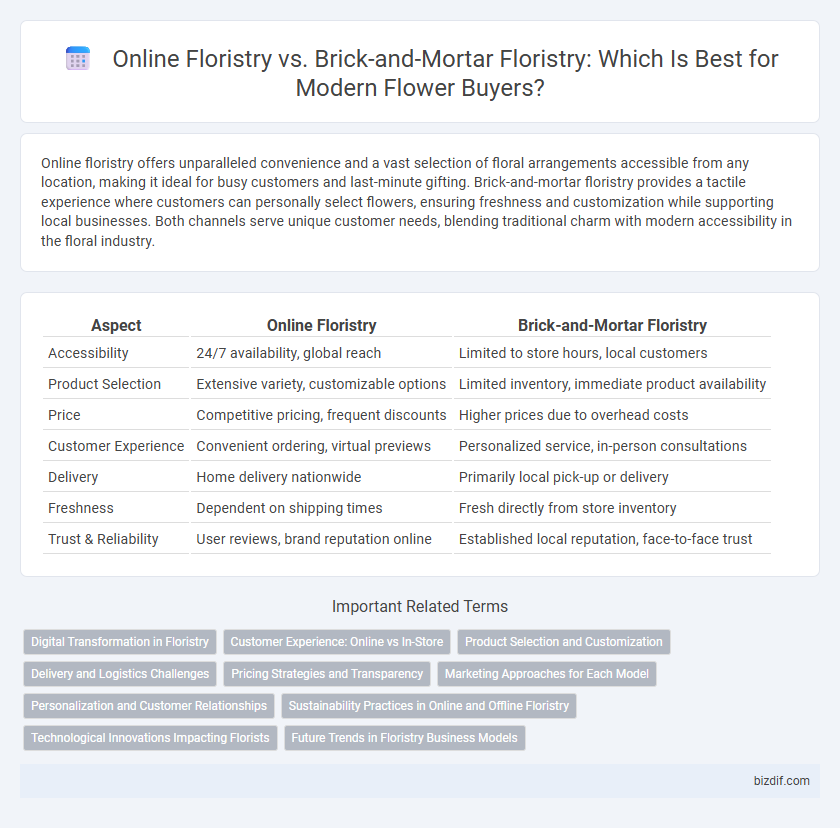Online floristry offers unparalleled convenience and a vast selection of floral arrangements accessible from any location, making it ideal for busy customers and last-minute gifting. Brick-and-mortar floristry provides a tactile experience where customers can personally select flowers, ensuring freshness and customization while supporting local businesses. Both channels serve unique customer needs, blending traditional charm with modern accessibility in the floral industry.
Table of Comparison
| Aspect | Online Floristry | Brick-and-Mortar Floristry |
|---|---|---|
| Accessibility | 24/7 availability, global reach | Limited to store hours, local customers |
| Product Selection | Extensive variety, customizable options | Limited inventory, immediate product availability |
| Price | Competitive pricing, frequent discounts | Higher prices due to overhead costs |
| Customer Experience | Convenient ordering, virtual previews | Personalized service, in-person consultations |
| Delivery | Home delivery nationwide | Primarily local pick-up or delivery |
| Freshness | Dependent on shipping times | Fresh directly from store inventory |
| Trust & Reliability | User reviews, brand reputation online | Established local reputation, face-to-face trust |
Digital Transformation in Floristry
Digital transformation in floristry has revolutionized traditional brick-and-mortar stores by integrating e-commerce platforms that offer real-time inventory updates, personalized floral recommendations powered by AI, and seamless online ordering with same-day delivery options. Online floristry leverages data analytics to track customer preferences and optimize floral arrangements, enabling businesses to scale efficiently while reducing waste. Enhanced digital marketing strategies and social media engagement expand brand reach, making online floristry a vital component in the modern floral industry ecosystem.
Customer Experience: Online vs In-Store
Online floristry offers customers convenience through 24/7 access to a wide variety of floral arrangements with detailed images and reviews, enhancing decision-making from home. Brick-and-mortar floristry provides a tactile experience where customers can see, smell, and customize flowers in person, fostering immediate satisfaction and personal connection. Both channels prioritize customer experience but differ in sensory engagement, personalization, and immediacy of service.
Product Selection and Customization
Online floristry offers an extensive product selection with customizable options such as personalized bouquets, seasonal flower varieties, and add-ons like vases or chocolates, enabling customers to tailor orders easily. Brick-and-mortar floristry provides hands-on customization through in-person consultation, allowing customers to choose specific flowers, scents, and arrangements with the guidance of experienced florists. Both platforms emphasize product variety, but online floristry excels in convenience and extensive inventory, while physical stores prioritize personalized, tactile experiences.
Delivery and Logistics Challenges
Online floristry faces complex delivery and logistics challenges such as maintaining flower freshness during transit and managing timely last-mile delivery, often relying on third-party couriers or specialized cold chain systems. Brick-and-mortar florists control in-store inventory and can offer immediate local delivery, reducing transit time and preserving floral quality. Efficient route planning and real-time tracking technology are critical for both models to minimize delays and enhance customer satisfaction in floral delivery services.
Pricing Strategies and Transparency
Online floristry often offers competitive pricing through reduced overhead costs and dynamic pricing models, enabling discounts and promotions tailored to customer behaviors. Brick-and-mortar florists typically maintain fixed pricing to cover higher operational expenses, emphasizing personalized service and quality assurance. Transparency in online platforms is enhanced by detailed product descriptions and customer reviews, while physical stores provide immediate product inspection and direct vendor interaction, influencing customer trust and perceived value.
Marketing Approaches for Each Model
Online floristry leverages digital marketing strategies such as SEO, social media advertising, influencer partnerships, and email campaigns to target a broad, tech-savvy audience and drive traffic to e-commerce platforms. Brick-and-mortar florists prioritize local marketing techniques, including community events, in-store promotions, loyalty programs, and collaborations with nearby businesses to build strong local customer relationships. Both models benefit from user-generated content and customer reviews, but online florists emphasize convenience and visual appeal, while physical shops focus on personalized service and experiential marketing.
Personalization and Customer Relationships
Online floristry leverages advanced algorithms and customer data to offer personalized bouquet recommendations and tailored floral arrangements, enhancing the shopping experience through customization. Brick-and-mortar florists excel in building direct, face-to-face customer relationships, providing immediate consultation and hands-on personalization that fosters trust and customer loyalty. Combining digital personalization tools with in-store expertise creates a comprehensive approach to customer engagement and satisfaction in floristry.
Sustainability Practices in Online and Offline Floristry
Online floristry often adopts sustainable practices by sourcing flowers from local growers and minimizing waste through precise inventory management, reducing carbon footprints associated with transportation and storage. Brick-and-mortar florists implement sustainability through eco-friendly packaging, water-efficient floral designs, and direct relationships with wholesalers to support regional flower farmers. Both models emphasize sustainable sourcing and waste reduction, but online floristry leverages technology for optimized supply chains while physical shops prioritize in-person quality and community engagement.
Technological Innovations Impacting Florists
Technological innovations such as augmented reality (AR) and AI-driven design tools have revolutionized online floristry by enabling customers to visualize arrangements before purchase, enhancing personalization and satisfaction. Brick-and-mortar florists benefit from point-of-sale (POS) systems integrated with inventory management software, improving operational efficiency and reducing waste. The adoption of online ordering platforms and same-day delivery technologies bridges the gap between traditional and digital floristry, creating a hybrid model that maximizes customer reach and convenience.
Future Trends in Floristry Business Models
Online floristry is expected to expand through AI-driven personalization and augmented reality tools that enhance virtual flower arrangement experiences, offering customers tailored selections based on preferences and occasions. Brick-and-mortar florists will integrate omnichannel strategies, blending in-store experiences with digital platforms to maintain customer engagement and convenience. Sustainability and same-day delivery services will become critical differentiators in both models as demand for eco-friendly products and rapid fulfillment continues to rise.
Online floristry vs Brick-and-mortar floristry Infographic

 bizdif.com
bizdif.com